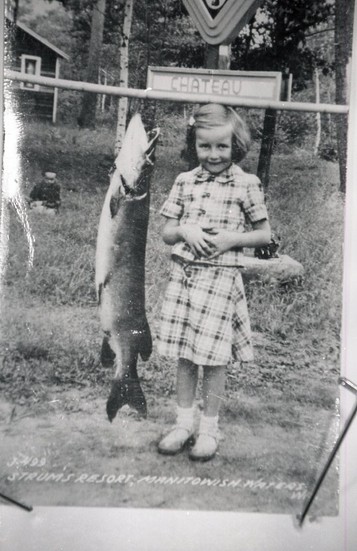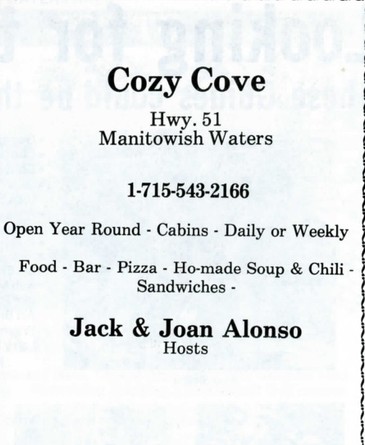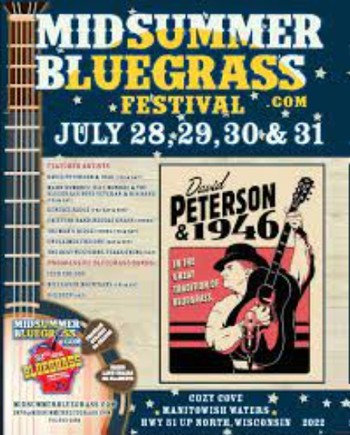History of the Cozy Cove
Introduction
Text-to-speech Audio
by Kay Krans
If you were visiting the Manitowish Waters area in the 1950s and looking for a great daytime activity for your family, you might have taken a horse ride through the woods, courtesy of the Flying “P” Stables. Eugene and Lela Poiron, their daughter, Darla, and their horses brought summertime memories for many.
Images
Christensen's Chateau

Chateau c1950s

1982 ad for Cozy Cove

Midsummer Bluegrass

Backstory and Context
Text-to-speech Audio
Today’s Cozy Cove Tavern holds the annual Midsummer Bluegrass Festival where greats from the genre have performed since 1989. Jerry Florian purchased the property in 1988 with the dream of creating an annual music festival in the Manitowish Waters community. Over the years, Wisconsin bluegrass bands as well as world famous bands, vocalists and instrumentalists in the bluegrass genre have been featured at this festival.
Originally, the property was built as a small resort with a tavern for gathering for meals and drinks. The land borders Highway 51 and the shoreline on Rest Lake. From the beginning, the property has had a history of great food and fun times. It also has a history of people who worked hard to create a business in the early years of the rise of tourism in the Northwoods.
The first to own and develop the property was Carl C. Christensen, a carpenter craftsman who designed and built the buildings, which he named The Chateau. He was a local town constable for only one week when he was shot and critically wounded in 1934 by one of the most infamous public enemies of the 1930s, Baby Face Nelson.
There are many stories about the series of owners who through their own personalities and business styles created their own version of what the tavern and cottages should be like. One of the owners was known for her beautiful singing voice, while other couples were known for their hospitality, humor and excellent cooking skills. Through the years, it was just a quiet bar for people to stop in and have a drink, eat wonderful ribs, have a good fish fry, meet a bunch of young adults, and party. Finally, it became the venue for the annual Midsummer Bluegrass Festival.
The story of The Chateau begins on the weekend of April 20-22, 1934, when the John Dillinger gang came to Little Bohemia, a place where they believed “no one would find them.” Federal Agents were in a race to capture the gang, and the criminals had very few places left to hide and be protected. Christensen had recently been elected town constable and was busy that weekend running the Northern Lights bar with his wife Anne. She was a popular cook, and beer was again legal in Wisconsin. People from the surrounding areas liked to take a Sunday drive and end up for lunch or dinner at their establishment. Henry Kuhnert, owner of the Northern Lights Lodge and Resort, had promised to sell to the Christensens if they could make a good business at the bar.
On Sunday, April 22, 1934, Special Agents Jay Newman and Carter Baum came to the Northern Lights bar and asked Carl to travel with them to show them possible escape routes from Little Bohemia, because the FBI believed they had the Dillinger gang trapped inside Little Bohemia Lodge. Carl told Anne to have lunches prepared for these men when they returned in about an hour. He was told to take his gun and ammunition with him. The three men were in a supped-up Chevy coupe that they had rented in Rhinelander. When opened up, the car could reach speeds of 100 miles an hour.
They traveled down Highway 10 (51 today) and stopped at the FBI staging point at Voss’ Birchwood Resort. Another agent came out of the lodge before they had time to park and told them to go to Koerner’s Resort because Mr. Koerner had called to say a car was parked close to their house, and they could not recognize it. The men reversed the car in the dark night surrounded by the tall pines and traveled the short distance north across the bridge to Koerner’s home.
As they pulled into the Koerner driveway, a group of men had just gotten into another car parked in front of the home. Christensen told the agents not to worry because the car belonged to a local. Newman rolled down his window and said, “Federal men here, identify yourselves.” In the other car were Emil Wanetka, Alvin Koerner, another Carl Christensen from Manitowish, and Baby Face Nelson. Nelson jumped from the car and ran up to the driver side of the law men’s car and put a gun in the face of Newman, saying “I’m going to hit you high, and I’m going to hit you low because I know you have bullet proof vests on.” He opened fire just as Newman leaned into his door to open it. Newman was grazed by a bullet to the side of his temple, and Baum was hit in the throat, neither having time to use their guns. Constable Christensen fell out of the passenger side of the car as Baum’s body rolled out on top of him. He pushed Baum off and tried to crawl away. Nelson came around the back of the car, putting eight bullets into Christensen. Nelson stole their car and raced off. Christensen laid there in the freezing night as he watched Baum breathe his last breath. Newman regained consciousness and rushed to find help. The men in the other car crawled off through the woods, fearing for their lives.
Christensen received aid almost an hour later and was rushed to Runstrom’s hospital in Ironwood, Michigan. He was not expected to live through the night, but he did and spent weeks in the hospital recovering. One bullet was left in his hip until it was removed when he was in his late 80s.
The federal government awarded Christensen $3,500 for his pain and suffering in his help with the battle with the Dillinger gang. In 1935, with that money, he and his wife built The Chateau on land they had purchased earlier for their homesite. They ran a very popular place, and he was known for his humor and pranks for the entertainment of his guests.
In 1944, they decided to sell and bought a farm in Saxon. They later returned to their hometown of Racine, and he went back to carpentry, which brought him north during the Great Depression for work that had all but dried up in the cities.
Walter and Norma Strum acquired the property from Christensen. Norma had a beautiful soprano voice and sang at special occasions. Her “Old Rugged Cross” rendition was very beautiful and powerful. In the 1950s, the Millers purchased the property from the Strums, who had retained the original name The Chateau. The Millers changed the name of their bar to Miller’s Bay. The Millers were city people but adjusted, and he supplemented his income by working for the town.
Harel Miller was hit by a car in the 1950s and was unable to work, so his very beautiful wife ran the establishment for him. His wife met a customer, fell in love, and left Miller. The customer invented an innovative part for church organs and became very wealthy.
While Miller owned the bar, it is said that he didn’t like strangers coming into his establishment. In order to be welcomed in, they had to prove that they would behave themselves at the bar. Harel was known to always wear a shirt with the sleeves rolled up. In 1966, he married a woman named Alice, and the place became well known for her excellent ribs. Alice had been very active in Wausau and ran bingo games there for many years. The place was nicknamed the “Wausau Pub” because so many people from Wausau came there for her ribs.
During the 1960s, young people enjoyed going to Miller’s Bay. Miller eventually sold to Evie and Tommy Copeland, calling it Copeland’s Cozy Cove. Those young patrons also would spend time across the highway at The Highland Club and then return to the Cozy Cove. Evie was highly regarded as a wonderful cook as well. In the late 1970s, Jack and Joan Alonzo purchased the Cozy Cove from the Copelands.
In 1988, Jerry Florian purchased Cozy Cove from the Alonzos. Florian named it on paper as the World Loppet Lodge, but publicly, it retains the Cozy Cove name. He and his father loved ice fishing and came to Vilas County on several fishing vacations. They liked to visit different bars and enjoyed thinking about having one someday. In 1988, Florian found the Cozy Cove, liked the place, and bought it.
Forian’s passion was bluegrass music, and thus started a lifelong dream of having an annual festival, which he named the Midsummer Bluegrass Festival. The first year for the festival was 1989, and it continues today. A music enthusiast from Tomahawk helped Florian gather several bands for that first year. As the years went on, Florian decided this should be a festival that attracted the greats in bluegrass. It was hard for him to convince talent agents that this was a place to book their talent. Manitowish Waters was small and difficult to get to. However, Florian connected with and became friends with Dallas Smith and the Band from Shiloh. Florian talked about Bill Monroe and how he wanted him to be part of the festival. Smith told him that Monroe owed him a favor and that he could get him to come to Manitowish Waters. After Smith called in the favor, Monroe said he would come. When the agent called Florian, he said, “I don’t know how you did it, but put Monroe on the venue for the next Midsummer Bluegrass Festival.”
Through the years, many of the bluegrass greats like Alison Krauss, Chubby Wise, the Osborne Brothers, the Dale Ann Bradley Band, the Georgia Rae Family Band, Vassar Clements, Larry Sparks, Amanda Cook, Rusty Ferrell, and Jimmy Campbell have entertained at the festival. The event is family orientated, and sometimes workshops are conducted on technique as well as music history. Jerry Florian has helped put bluegrass on the Wisconsin Northwoods map for over 30 years.
Cite This Entry
Bokern, Jim . "History of the Cozy Cove ." Clio: Your Guide to History. March 20, 2024. Accessed March 13, 2025. https://theclio.com/entry/178385
Sources
Bluegrass Bios, Profiles of the Stars. https:/bluegrassbios.com
Bluegrass Music Hall of Fame and Museum. https:/bluegrasshall.org
Bluegrass Today. https:/bluegrasstoday.com
IMbD. https:/m.imbd.com
Interview Jerry Florian, Promoter of Midsummer Bluegrass Festival and owner of Cozy Cove. February 10, 2023.
Chicago Tribune (Chicago, Illinois) For sale Ad. May 23, 1942.
Oconto County Reporter (Oconto, Wisconsin) July 20, 2018.
Wausau Daily Herald (Wausau, Wisconsin) Blue Grass Festival Ad. July 24, 1998.
Manitowish Waters Historical Society
Manitowish Waters Historical Society
Manitowish Waters Historical Society
Facebook https://images.app.goo.gl/2b44LApWU2wPeFvF8
